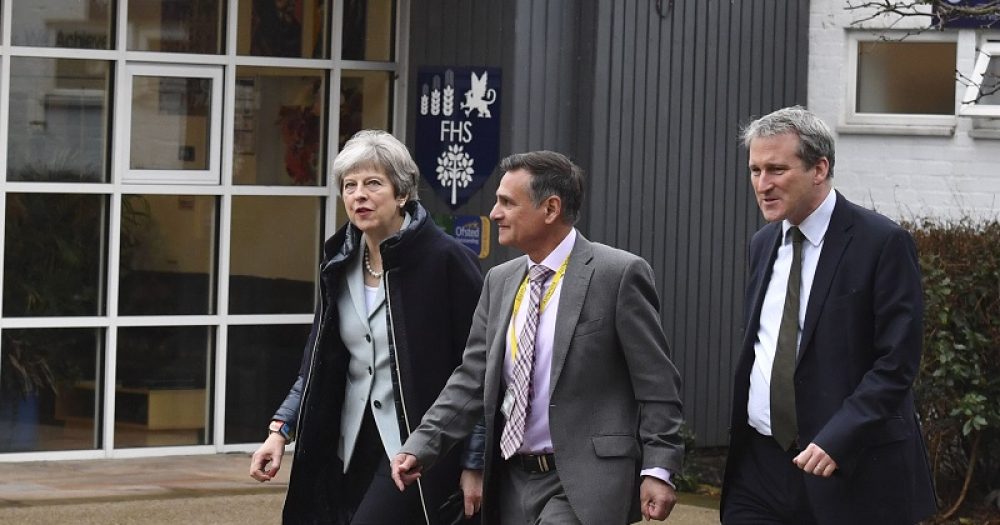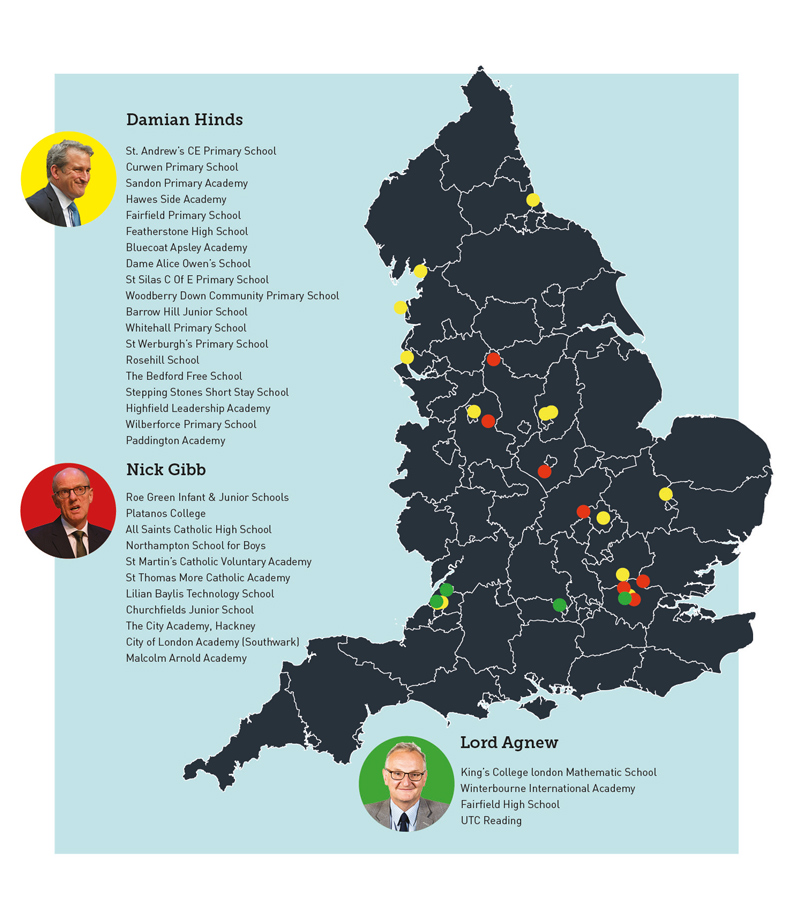The education secretary has visited more than twice as many academies and free schools than maintained ones – and just one special school – in the first four months of his job.
Details of Damian Hinds’ visits were released to Schools Week as part of a Freedom of Information request.
Between January and the end of April, Hinds visited 13 mainstream academies and five maintained schools. He also visited one community special school and a pupil referral unit.
Ministers in successive governments have prioritised visits to their favourite types of schools: academies and free schools
Nick Gibb, the schools minister, had the same ratio during this period, visiting eight academies and three maintained schools.
Lord Agnew, the minister for the school system, visited a specialist maths free school sixth-form, a UTC and two academies, but no maintained schools at all.
Only 35 per cent of schools are academies, according to the National Audit Office.
Kevin Courtney, the joint general secretary of the National Education Union, said an “ideological obsession” with academies was in “in danger of skewing ministers’ professional duties and responsibilities for all schools”.
“It is unacceptable that ministers do not visit all types of schools in equal measure so that they can fully understand the range of the work that goes on and the good practice across all school types,” he told Schools Week.
“This is nothing new,” added Janet Downs, from the Local Schools Network, which campaigns against academies and in favour of more local oversight of schools.
“Ministers in successive governments have prioritised visits to their favourite types of schools: academies and free schools. Such visits are then used to praise these schools to give the impression they are superior to ‘council run’ schools.
“But the majority of schools are still under the stewardship of local authorities. It appears ministers have little interest in visiting these.”
This trend was set by former education secretary Nicky Morgan who visited twice as many academies as maintained schools in her first year in office.
Geoff Barton, the general secretary of school leaders’ union ASCL, wants ministers to visit a “broader range of schools”.
“Nothing will be of more use to them than listening to the first-hand experiences of a broad range of school leaders, teachers and students,” he continued. “Ministers will be able to see for themselves the brilliant work being done in so many schools as well as the challenges they face”.
Most of the 25 academies visited by ministers in the first four months of the year were members of single-academy trusts or very small multi-academy trusts, including Bedford Free School, part of the two-school Advantage Schools trust, which was already visited last year by former education secretary Justine Greening.
A Department for Education spokesperson said Hinds had “repeatedly made clear” his priority is to deliver “world class education, training and care for everyone, whatever their background”.
This has been underlined in major announcements on technical education, good school places and better early years education over the past few months, “and any suggestion otherwise is completely false”, she said.
Image: Prime Minister Theresa May walks with headteacher Gerry Wadwa and education secretary Damian Hinds during a visit to Featherstone High School in west London in February. Credit: Press Association









Well what on earth do you expect?
If we had a Labour Government, how many Grammar Schools and Independent Schools do you think Angela Rayner would visit in her first four months? Don’t you think she would visit proportionally more LA schools than academies (taking into account the ratio)?
The Conservative Government (as did the Coalition) has a policy of academisation. Whether you agree with the principle of academisation or not, to feign surprise when a politician visits more places that align with their policies is naive at best.
Let’s imagine a situation where Labour are voted in and decide to change how hospitals are run. They start a programme whereby the Acute Trusts that run hospitals are transferred into the ownership of the local community. After a while 50 hospitals (out of the 168 in England) are now owned by the community. We get a new Health Secretary. Out of the first 15 hospitals he visits, I’d put my house on the fact that over 75% (if not over 90%) of them would be the ‘local community hospitals’.
This is a complete non-story, padded out by length quotes from three individuals implacably opposed to the academies programme.
Mark: as one of the ‘three individuals implacably opposed to the academies programme’, I’d agree with you that we shouldn’t be surprised when minsters who push a particular policy only visit places viewed as shining examples of this policy.
But that doesn’t make it right.
The Department for Education is supposed to support all schools not just ones promoted by ministers. Pointing out favouritism by politicians doesn’t make it a ‘non-story’ just because they can all be accused of this partisan approach.
http://www.localschoolsnetwork.org.uk/2012/03/deception-about-academies-has-been-going-on-since-they-first-opened
What relevance at all does it have which schools Damian Hinds visited to how DfE supports schools?
If 15 of the 20 schools he visited were located in urban centres, does that mean DfE won’t be supporting rural schools?
I live in the SouthWest. Looks like he only visited one school in my region – should I be worried the DfE won’t be supporting schools in the SouthWest as much as schools in the NorthWest?
Yes, this article shows that the DfE shows favouritism when it comes to which schools are visited by Government ministers.
But it doesn’t give one iota of evidence that this translates into less support for LA schools.
By the way, I just noticed that the article says “most of the 25 academies visited by ministers in the first four months of the year were members of single-academy trusts or very small multi-academy trusts.”
As you’re very well aware, the DfE’s current “ideological obsession” (if you will) is with larger multi-academy trusts, so the fact they’re not visiting these academies doesn’t really fit the accusation …
Mark. It is totally unfair to have a battle of wits with poorly armed opponents. Effectively government is accused of ideological bias by people with an ideological bias. Elected governments and councils giving patronage to those who exemplify their approach or policies is totally normal. This applies to left right and centre. If this is a problem then democracy is the problem.
Governments and councils who give ‘patronage’ to those who support their ideology are acted in a corrupt manner. It should not be regarded as ‘normal’.
However, giving rewards to government supporters in the form of, say, contracts, is not what is being discussed here. It’s ministers’ blinkered approach to visiting state schools.
Hi Janet.
Any chance you could answer my question above?
You said that the DfE is supposed to support all schools not just ones promoted by ministers, and I would be interested to know how the types of schools visited by the Education Secretary has a direct correlation to how DfE supports different types of schools.